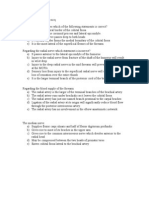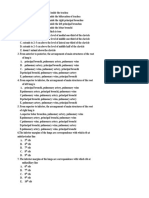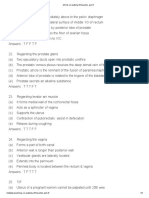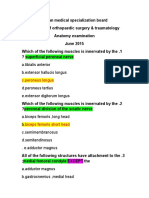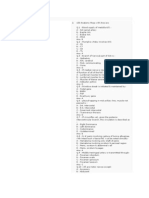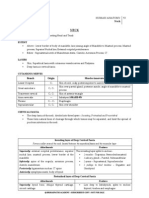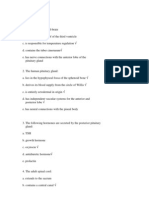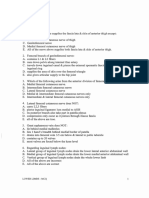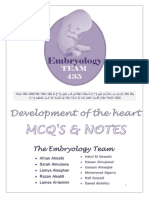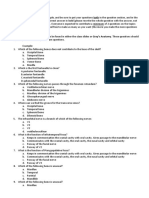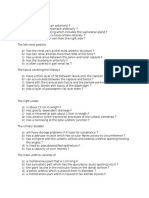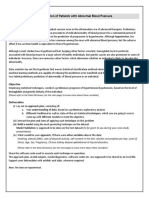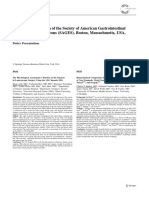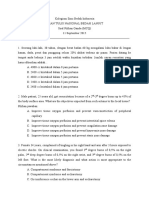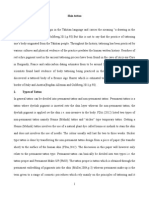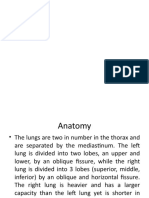MCQ in Abdomen
MCQ in Abdomen
Uploaded by
Jayathra LiyanagamageCopyright:
Available Formats
MCQ in Abdomen
MCQ in Abdomen
Uploaded by
Jayathra LiyanagamageOriginal Description:
Original Title
Copyright
Available Formats
Share this document
Did you find this document useful?
Is this content inappropriate?
Copyright:
Available Formats
MCQ in Abdomen
MCQ in Abdomen
Uploaded by
Jayathra LiyanagamageCopyright:
Available Formats
ABDOMEN
1. Regarding the kidney
a) Upper pole of the left kidney is related to the pleura. T
b) Polycystic kidney is caused by persistence of nephrons that normally degenerate. F
c) Collecting ducts drain into the calyces through papillae. F
d) Segmental arteries supply a specific area in the kidney. T
e) Ureteric pain is felt in the areas of T12-L2. F
2.
a)
b)
c)
d)
e)
f)
g)
h)
i)
T/F
Descending colon is supplied by pelvic splanchnic nerves. [F]
Anterior gastric nerve is formed by the right vagus. [F]
Megacolon occurs due to absence of autonomic nerve fibres.
Urogenital diaphragm is a voluntary sphincter of the bladder. [T]
Splanchnic nerves supply distal part of large intestine.
[F]
Hemorrhoids result from blocked venous drainage of superior rectal vein. [T]
Internal anal sphincter extends throughout the length. [F]
Kidney has segmental blood supply. [T]
Upper poles of kidneys are posteriorly related to the costodiaphragmatic recess.
j) Short gastric arteries pass along the gastrophrenic ligament.
[T]
k) Stomach drains directly to the supraclavicular nodes. [F]
l) Ureter passes close to the supravaginal part of the cervix of the uterus. [T]
3.
b)
c)
d)
e)
f)
Anal canal & rectum
In sagittal plane it follows curvature of sacrum. [T]
All sides of rectum are covered by peritoneum. [F]
Internal anal sphincter is found through the whole length of anal canal.
External haemorrhoids occur in the external rectal venous plexus. [T]
Stratified squamous epithelium is found below the white line.
[T]
4. The right kidney
a) The renal artery is anterior to the renal vein.
[F]
b) Upper pole is closely related to the diaphragm and pleura. [T]
c) Lower pole lies in the infracolic compartment. [T]
d) Fibrous capsule is directly continuous with the transversalis fascia.
e) Supra renal glands separate it from the liver.
[F]
5.
a)
b)
c)
d)
Regarding the vagina
The upper part develops from the sinovaginal bulb. [F]
Posterior fornix is closely related to the peritoneal cavity. [T]
Anterior wall is related to the base of the bladder. [T]
Lymph from upper part drains into the internal iliac nodes. [F]
[F]
[F]
[T]
e) Internal surface is lined by pseudostratified columnar epithelium.
6.
a)
b)
c)
d)
e)
T/F regarding the left kidney
It is posterior to the omental bursa.
[T]
Is separated by the descending colon by the peritoneum.
It is posterolateral to the left suprarenal gland. [T]
Its hilum is at L1 vertebral level.
[T]
Has 3 minor calyces. [F]
[F]
[F]
7. Regarding the peritoneum
a) The two coronary ligaments enclose the bare area of the liver. [T]
b) Splenic vessels are found in the lienorenal ligament. [F]
c) Left ureter is located in the inter sigmoid recess. [T]
d) The third part of the duodenum is related to the root of the mesentery. [T]
e) Fissure for the ligamentum venosum provides attachment to the lesser omentum.
8. Regarding the liver
a) Develop in the septum transversum. [F]
b) The central vein is included in the portal triad. [F]
c) It is supported by the hepatic veins. [T]
d) The IVC lies at the base of the bare area of the liver. [T]
e) The gall bladder is between ligamentum teres and the quadrate lobe.
9.
a)
b)
c)
d)
e)
[F]
Regarding the testis
Contains no spermatogonia in children. [T]
Drains into deep inguinal nodes. [F]
Has no parasympathetic supply.
[T]
Is enlarged in fragile X syndrome.
If detected in the inguinal canal is called ectopic. [F]
10. Regarding duodenum
a) Arterial supply is entirely derived from the celiac trunk.
[F]
b) The duodenal cap on X ray is due to first part of it.
[T]
c) There are glands in the submucosal layer.
[T]
d) Hepatoduodenal papilla opens into the major duodenal papilla.
e) Right ureter lies posterior to the third part.
[T]
[T]
[T]
11. T/F regarding the urinary bladder
a) Allantois participates in the development of the bladder.
b) Is held in place by puboprostatic ligaments. [T]
c) Pelvic splanchnic nerves are inhibitory to the detrusor muscle and motor to the internal
sphincter. [F]
d) Posterior rupture of the bladder results in escape of urine intraperitonially. [F]
e) In infants and children the urinary bladder is in the abdomen even when empty
[T].
12. Cervix of the uterus
a) Triangular in shape. [F]
b) Directly overlies the superior surface of the bladder without in between peritoneum.
c) Uterine arteries are laterally related. [T]
d) Supported by transverse ligament. [T]
e) Supplied by the vaginal artery.
[T]
[T]
13. Regarding the posterior abdominal wall
a) The quadratus lumborum lies in the anterior compartment of the lumbar fascia. [T]
b) The quadratus lumborum prevents the elevation of the 12th rib during contraction of the
diaphragm. [T]
c) The iliacus is supplied by the femoral nerve. [T]
d) Psoas major muscle is an extensor of the hip joint.
[F]
14. About rectus abdominis
a) Has a medial head arising from anterior pubic ligament. [T]
b) Is inserted into 5th 6th & 7th ribs. [F]
c) Is supplied by the 1st lumbar nerve. [F]
d) Posterior wall extends above costal margin. [T]
e) Has an anterior sheath fixed to the muscle by tendinous intersections.
15. Which of the following are related with the organ specified?
a) Mcburneys point and the tip of the appendix. [F]
b) Murphys point and the fundus of the gallbladder. [T]
c) Subcostal plane and 2nd lumbar vertebra. [F]
d) Posterior inferior iliac spine and end of dura mater. [T]
16. Regarding the arteries of the abdominal wall
a) Superior thoracic artery arises from the thoracic aorta. [F]
b) Collateral branch arises from the posterior intercostal artery
c) Internal thoracic artery divides at the costal margin. [T]
d) Coarctation results in notching of ribs. [T]
[F].
17. Biliary system
a) Cystic duct joins the common hepatic at an acute angle.
b) Gallbladder capacity is 30-50ml.
[F]
[T]
[T]
c) Cystic artery arises from right hepatic artery.
[T]
d) Mucosa of gallbladder contains numerous mucous glands.
[F]
18. Constrictions of the ureter are found
a) Opposite the transverse process of L3. [F]
b) At the junction between renal pelvis and ureter. [T]
c) Lateral to the lateral fornix of the vagina. [F]
d) Sacroiliac joint.
[T]
e) When it enters the bladder. [T]
19. T/F
a) Axis of the uterus lies in line with the axis of the cervix. [F]
b) Pouch of Douglas lies between posterior fornix of vagina and lower third of the rectum.
c) In the primordial follicle primary oocyte has commenced meiosis I.
[T]
d) In the nulliparous woman external os is a transverse slit. [T]
e) In ovarian fossa obturator nerve lies lateral to the ovary. [T]
20. Pelvic peritoneum covers,
a) Posterior fornix
[T]
b) Anterior surface of vagina [F]
c) Uterine tubes T]
d) Second piece of the sacrum [T]
e) Lower 1/3 of the rectum
[F]
21. Regarding levator ani
a) Inferior surface is covered with pelvic fascia.
[T]
b) It forms the superior surface of the ischiorectal fossa
[T]
c) It is supplied by the inferior rectal nerve.
[T]
d) Pubococcygeus part of the levator ani is partly connected with muscle coat of rectum. [T]
e) Iliococcygeus arises from ischial spine. [T]
[F]
You might also like
- Psychopathy Checklist - Youth Version (PCL-YV)Document130 pagesPsychopathy Checklist - Youth Version (PCL-YV)Dany BarretteNo ratings yet
- Compiled MSPC 235 Past Questions Volume IIIDocument15 pagesCompiled MSPC 235 Past Questions Volume IIIPaapaErnestNo ratings yet
- Anatomy Forearm MCQDocument2 pagesAnatomy Forearm MCQthevampire20104825100% (1)
- Wiki Abdomen Mcqs ExplainedDocument9 pagesWiki Abdomen Mcqs Explainedchemptnk100% (2)
- Dr:Khalid MiladDocument27 pagesDr:Khalid MiladMohsen Elzobna0% (1)
- Thorax ExamDocument3 pagesThorax ExamMarera DomnicNo ratings yet
- All Anatomy Mini QuestionsDocument112 pagesAll Anatomy Mini QuestionsDiMa Marsh100% (4)
- Questionnaire of AnemiaDocument17 pagesQuestionnaire of AnemiaRashmi AryaNo ratings yet
- MCQs On Anatomy of The Pelvis - Part 3Document3 pagesMCQs On Anatomy of The Pelvis - Part 3sobanNo ratings yet
- MCQs On Anatomy of The Pelvis - Part 1Document3 pagesMCQs On Anatomy of The Pelvis - Part 1soban67% (3)
- MCQs On Anatomy of The Pelvis - Part 4Document3 pagesMCQs On Anatomy of The Pelvis - Part 4sobanNo ratings yet
- Anatomy (Chapter - More MCQS) Solved MCQs (Set-1)Document5 pagesAnatomy (Chapter - More MCQS) Solved MCQs (Set-1)Saleem AliNo ratings yet
- 2009 Anatomy MCQsDocument10 pages2009 Anatomy MCQsAndrew Kalaw100% (2)
- 3-Embryology of Respiratory SystemDocument25 pages3-Embryology of Respiratory SystemNur HikmahNo ratings yet
- AnatomyDocument11 pagesAnatomyoddone_outNo ratings yet
- Practice Test 2 Upper LimbDocument4 pagesPractice Test 2 Upper LimbhavokkNo ratings yet
- Anatomy MCQ 1Document15 pagesAnatomy MCQ 1Maria75% (4)
- Abd MCQDocument3 pagesAbd MCQerisamwaka100% (2)
- Sudan Medical Specialization Board 2Document37 pagesSudan Medical Specialization Board 2Dania Zaid100% (1)
- 100 Anatomy Mcqs With AnswersDocument13 pages100 Anatomy Mcqs With Answersqudsia_niazi100% (2)
- Anatomy Mcqs (2) - 1Document13 pagesAnatomy Mcqs (2) - 1Yashfa Yasin - PharmDNo ratings yet
- Anatomy Answer KeyDocument16 pagesAnatomy Answer Keylovelots1234No ratings yet
- Final MCQ Form A ModifiedDocument5 pagesFinal MCQ Form A ModifiedhamdyyalyNo ratings yet
- Mcqs in Upper Limb: DR - Khalid MiladDocument10 pagesMcqs in Upper Limb: DR - Khalid MiladOzgan SüleymanNo ratings yet
- C. Cardiac Notch: Evaluation Exam (Lungs Heart)Document4 pagesC. Cardiac Notch: Evaluation Exam (Lungs Heart)MARIA RADELINE LUNo ratings yet
- Lower Limb Mcqs MergedDocument148 pagesLower Limb Mcqs MergedCaim ZNo ratings yet
- Anatomy Exam 1 Thorax Part 2 With Answers PDFDocument13 pagesAnatomy Exam 1 Thorax Part 2 With Answers PDFUu UuNo ratings yet
- Section (A) Answer The Following Questions by Choosing The Letter of The Best AnswerDocument6 pagesSection (A) Answer The Following Questions by Choosing The Letter of The Best AnswerAshraf Alamin AhmedNo ratings yet
- Anatomy MCQS Part 4 PDFDocument20 pagesAnatomy MCQS Part 4 PDFSamer Qusay100% (1)
- Branchial PlexusDocument7 pagesBranchial PlexusSuhas IngaleNo ratings yet
- Anatomy MCQSDocument13 pagesAnatomy MCQSdrpnnreddy100% (1)
- Quiz Low Limb 2019-DikonversiDocument9 pagesQuiz Low Limb 2019-DikonversiwillysvdNo ratings yet
- Khartoum University - Faculty of Dentistry Enterance Examinations McqsDocument24 pagesKhartoum University - Faculty of Dentistry Enterance Examinations McqsHazim Rhman AliNo ratings yet
- Quiz On The HeartDocument11 pagesQuiz On The HeartNajah HanimNo ratings yet
- Practice Quiz - Anterior Triangle of The NeckDocument7 pagesPractice Quiz - Anterior Triangle of The NeckWongani ZuluNo ratings yet
- Anatomy 2020 LLDocument12 pagesAnatomy 2020 LLjhom smith100% (1)
- Anatomy McqsDocument3 pagesAnatomy McqsMunazzaNo ratings yet
- NeuroanatomyDocument7 pagesNeuroanatomyEslam Almassri100% (1)
- The Posterior Belly of The Digastric Muscle Is Innervated by A Branch of This Cranial Nerve: A. VDocument39 pagesThe Posterior Belly of The Digastric Muscle Is Innervated by A Branch of This Cranial Nerve: A. VghanimNo ratings yet
- AnatomyDocument34 pagesAnatomyShubham Hiralkar100% (2)
- Anatss Final ExamDocument76 pagesAnatss Final ExamKarl Torres Uganiza RmtNo ratings yet
- 015 Anatomy MCQ ACEM Primary PDFDocument14 pages015 Anatomy MCQ ACEM Primary PDFMoiez Ahmad100% (1)
- AnatomyDocument4 pagesAnatomyFaisal AwanNo ratings yet
- Head Neck MCQ With Explanation - 5 PDFDocument5 pagesHead Neck MCQ With Explanation - 5 PDFMohamed Ghabrun100% (2)
- New ExamDocument15 pagesNew Exam_RedX_No ratings yet
- Upper Limb Solved MCQs (Set-1)Document6 pagesUpper Limb Solved MCQs (Set-1)Fawad KtkNo ratings yet
- MCQ Question BankDocument102 pagesMCQ Question Bankdrmadaanpiyush100% (1)
- MCQ On AbdomenDocument10 pagesMCQ On AbdomenbeulaholuwabunkunfunmiNo ratings yet
- Abdomen, Thorax, Embryology MCQsDocument10 pagesAbdomen, Thorax, Embryology MCQsashok ashu100% (1)
- Past Papers For Anatomy GISDocument23 pagesPast Papers For Anatomy GISMohammad DarkhabaniNo ratings yet
- Upper Limb MCQ AnswersDocument3 pagesUpper Limb MCQ AnswerschiNo ratings yet
- Development of The Heart 'Mcq's and Note 'Document3 pagesDevelopment of The Heart 'Mcq's and Note 'Florence BamigbolaNo ratings yet
- Head Neck MCQ With Explanation - 4 PDFDocument5 pagesHead Neck MCQ With Explanation - 4 PDFMohamed GhabrunNo ratings yet
- Anatomy MCQS: Abdomen: 1 BC 2 D 3 CD 4 B 5 D 6 A 7 C 8 D 9 E 10 BCD 11 CDE 12 BC 13 BCDDocument37 pagesAnatomy MCQS: Abdomen: 1 BC 2 D 3 CD 4 B 5 D 6 A 7 C 8 D 9 E 10 BCD 11 CDE 12 BC 13 BCDPeter BoatengNo ratings yet
- Lower Limb, Abdomen & Pelvis Questions I MbbsDocument11 pagesLower Limb, Abdomen & Pelvis Questions I MbbsDarshan AcharyaNo ratings yet
- Unit 1 Embryo Q and A ModuleDocument76 pagesUnit 1 Embryo Q and A ModuleBAYAN NADER YOSRI JABARI 22010404No ratings yet
- Skull and Orbital Cavity Anatomy QuestionsDocument9 pagesSkull and Orbital Cavity Anatomy QuestionsAnon AnonNo ratings yet
- Practice Quiz Answers - Upper Limb, Axilla and Brachial PlexusDocument3 pagesPractice Quiz Answers - Upper Limb, Axilla and Brachial PlexusRobert EdwardsNo ratings yet
- Anatomy 2021 FinalDocument2,156 pagesAnatomy 2021 Finalansh tyagiNo ratings yet
- 1 SEMESTER 18/19: Median Nerve-Carpal Tunnel Weakens Lateral 3 Digits Sensory Loss ParalysisDocument60 pages1 SEMESTER 18/19: Median Nerve-Carpal Tunnel Weakens Lateral 3 Digits Sensory Loss ParalysisInsaf AhamedNo ratings yet
- MCQS GitDocument9 pagesMCQS GitMuhammad AdnanNo ratings yet
- MCQ GenitourinaryDocument3 pagesMCQ Genitourinaryanojan100% (4)
- Advances in Environmental Research, Volume 13Document585 pagesAdvances in Environmental Research, Volume 13cpavloudNo ratings yet
- CHAPTER-5-Physical Fitness, Wellness & LifestyleDocument56 pagesCHAPTER-5-Physical Fitness, Wellness & Lifestyledevarshdoshi1305No ratings yet
- World Expert Explains Link Between EMF and Human Disease, Radiation in Ireland 1,000 Times Higher Than RecommendationDocument12 pagesWorld Expert Explains Link Between EMF and Human Disease, Radiation in Ireland 1,000 Times Higher Than RecommendationGon YoNo ratings yet
- Horner SYndromeDocument3 pagesHorner SYndromeHendri Wijaya WangNo ratings yet
- ISH Guideline Presentation Slide Deck 06.05.2020Document105 pagesISH Guideline Presentation Slide Deck 06.05.2020betcyyyNo ratings yet
- Para JumblesDocument4 pagesPara JumblesKarthi KeyanNo ratings yet
- Liposuction TechniquesDocument12 pagesLiposuction TechniquesAde Wildan Rizky Fachry100% (1)
- Multiple Sclerosis LancetDocument15 pagesMultiple Sclerosis LancetMichelleNo ratings yet
- Kode Icd XDocument39 pagesKode Icd XBrianne Gilbert87% (15)
- Cardiac ArrhythmiaDocument5 pagesCardiac ArrhythmiaDennis CobbNo ratings yet
- Larvivorous Fish PDFDocument15 pagesLarvivorous Fish PDFHarsh KaushikNo ratings yet
- Q&A Random Selection #16Document5 pagesQ&A Random Selection #16Yuuki Chitose (tai-kun)No ratings yet
- Martial Arts 72 Shaolin Skills Dim Mak PDFDocument49 pagesMartial Arts 72 Shaolin Skills Dim Mak PDFWilyanto Yang100% (2)
- Case Study - Classification of Patients With Abnormal Blood Pressure (N 2000)Document2 pagesCase Study - Classification of Patients With Abnormal Blood Pressure (N 2000)Deepak GuptaNo ratings yet
- Theories of Crime Early Biological TheoriesDocument6 pagesTheories of Crime Early Biological TheoriesCharmis TubilNo ratings yet
- CaecilianDocument3 pagesCaecilianlukinandaNo ratings yet
- ISO STANDARDS - Health Care TechnologyDocument9 pagesISO STANDARDS - Health Care TechnologyvesnaNo ratings yet
- Art:10.1007/s00464 016 4771 7Document176 pagesArt:10.1007/s00464 016 4771 7Radu MiricaNo ratings yet
- Pharmacology II OutlineDocument52 pagesPharmacology II Outlinerjones53No ratings yet
- Report On ML NEW ProjectDocument5 pagesReport On ML NEW ProjectPraveen Kumar UmmidiNo ratings yet
- Soal Bedah LanjutDocument32 pagesSoal Bedah LanjutYuda ArifkaNo ratings yet
- Sample Assignment Skin TattooDocument5 pagesSample Assignment Skin TattooscholarsassistNo ratings yet
- New or Expectant Mothers in The Workplace : BulletinDocument3 pagesNew or Expectant Mothers in The Workplace : BulletinSuman KumarNo ratings yet
- Record Medical HistoryDocument2 pagesRecord Medical History29. Stella NeryNo ratings yet
- Gossypol PoisoningDocument14 pagesGossypol PoisoningSharun Khan SkNo ratings yet
- 2016 FEP BlueVisionDocument2 pages2016 FEP BlueVisionGopal Gopinath100% (1)
- Health Declaration FormDocument3 pagesHealth Declaration FormJeremy Sigarlaki100% (1)
- LobectomyDocument19 pagesLobectomyRamchandra ChaliseNo ratings yet


